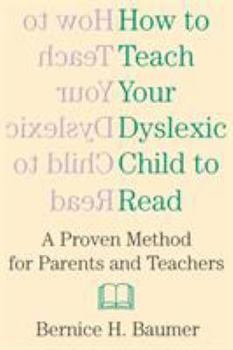How To Teach Your Dyslexic Child To Read: A Proven Method for Parents and Teachers
Select Format
Select Condition 
Book Overview
Every dyslexic child can learn to read, write, and spell--thanks to this one-on-one, easy-to-use, instructional book, which is broken down into three parts: Part 1 --- Discusses learning disabilities. Each problem is followed by a true case study of how a child overcame thatdisability. Part 2 -- Reveals how a dyslexic child should be taught--from kindergarten through the third grade--step by step. It also gives detailed instructions for teaching phonics, spelling, and syllabication. Part 3 -- Contains the pictures, charts, and word lists that are an integral part of tutoring the child. Since each dyslexic is different, the parent or teacher must carefully determine how to structure lessons in order to connect with the child. How to Teach Your Dyslexic Child to Read teaches the tutor how to discover the child's learning pace; how to lengthen a youngster's short attention span; how much drill and review is necessary once a phonics concept has been introduced; how many vocabulary words the child should be asked to learn at one time; how many pages should be assigned to daily oral reading; how many words a child can learn to spell in a week, and remember how to spell when writing sentences; and more. Reading opens new worlds for children. But for the dyslexic child those worlds go unexplored, and not knowing how to read can be frustrating and embarrassing. With this essential guide, parents, teachers, and tutors can make a tremendous difference in a child's life.
Format:Paperback
Language:English
ISBN:0806519819
ISBN13:9780806519814
Release Date:January 1998
Publisher:Kensington Publishing Corporation
Length:176 Pages
Weight:0.64 lbs.
Dimensions:0.5" x 5.9" x 9.2"
Customer Reviews
3 ratings
A helpful and quick read
Published by Thriftbooks.com User , 17 years ago
We used this book for our book club. It had practical ideas and was the guide for creating a simple information booklet to help parents work with their children.
The First Book on Dyslexia to be read by Parents
Published by Thriftbooks.com User , 26 years ago
As a parent of a dyslexic child, I've read most of the recommended books on the subject. Of all of them, this is the first one I would recommend to parents who have realized that their child is dyslexic. The author presents most of the classical techniques in dealing with the dyslexic learning style in an exceptionally clear, concise, and very human style. She uses as a vehicle to do this her own experience in teaching dyslexic children and young adults. After using these techniques with my own daughter, I can say that many are quite helpful. In the course of describing the learning-to-read process with dyslexic kids, the author also brings some practical thinking to the "phonics vs. whole-word" reading debate. She explains the necessity of phonics for word-attack skills in non-intuitive readers as well as the ultimate necessity of whole-word reading in order to establish fluency and comprehension.At the end of the book she provides most-used word-lists, phonics charts, writing charts, and pictures. She tells you how to use these materials in applying the techniques previously described.This book is not revolutionary nor does it promise a panacea for all the issues surrounding the dyslexic learning style. But, I recommend that you make it your first of several on this complex subject.
a good beginning for parents who want to help their dyslexic
Published by Thriftbooks.com User , 26 years ago
The book describes "how to" approaches to work with a dyslexic child at home. What the author suggests does not conflict with methodology that might be used in the classroom, but rather it complements any specialized, commercialized multisensory approach used at school. When parents of actual elementary dyslexic students viewed the book, they could actually understand what the author suggested doing. Various activities suggested by the author could be prepared and conducted by parents in a few minutes per day. It's a book well worth reading, by both teachers and parents of dyslexic students.






